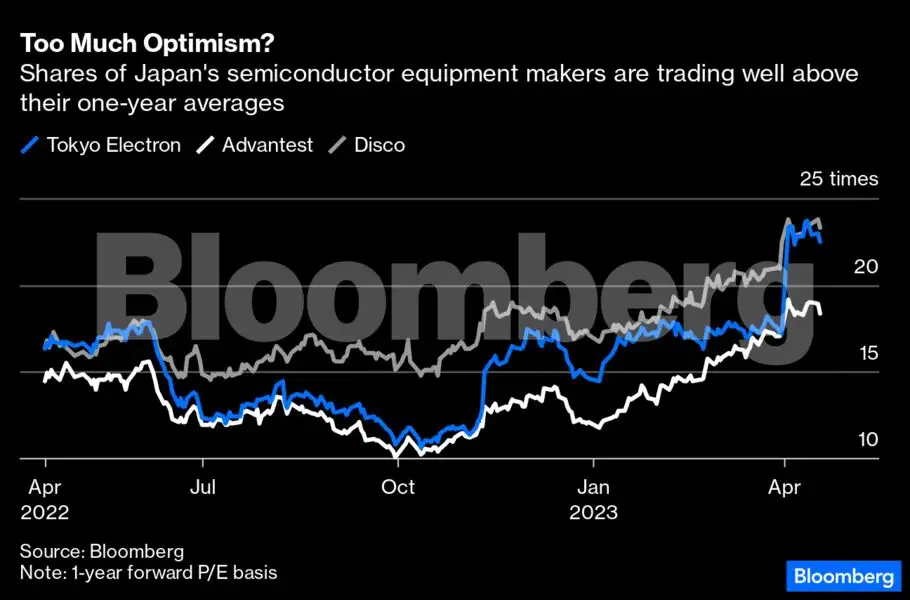Companies don’t seem too perturbed, though, nor do investors. Some chip machinery maker stocks are trading at heady valuations. They are finding comfort in the backlog of orders that will tide these firms through the troughs. Those that aren’t sitting on cushy buffers will wait it out as they’ve done in years past. SEMI, the industry association, projects a 17% drop in front-end process equipment. For others that cut wafers into chips, or the back-end process, sales are likely to drop 9%. The forecast downturn follows record sales of semiconductor manufacturing equipment that rose to $107.6 billion in 2022.
 Bloomberg
BloombergTrouble is, the already complex cycle is getting trickier to predict. Usually, companies forecast demand two years in advance, ordering tools and building factory shells without populating them with machines. The chip cycle turns every three to five years. Every time, it’s pretty consistent, falling for a few years and bouncing back up, even if the exact timing, depth and speed of the rebound is harder to determine, says Peter Hanbury of Bain & Co., a consulting firm. In downturns, cash costs are so low companies keep running plants, but future capital gets cut. Firms have worked out how to deal with the predictable variables and have become immune to the ups and downs. The broader upward trajectory keeps manufacturers humming along, churning out equipment that will, sooner or later, get installed in fabrication facilities. Or that’s how it used to be. There is now a new, and meaningful, set of variables to consider. Those range from export restrictions on Beijing, significant investments made by Chinese producers to huge government subsidies and incentives handed out by the US and Europe, along with geopolitical tensions and rising technology costs. Executives at one of the largest machinery makers, Lam Research Corp., called the broader changes in the industry “an unprecedented business environment” during the company’s earnings call in late January. Forecasts that don’t take these factors into account — or that underestimate their impact — are likely to be far too optimistic.
 Bloomberg
BloombergSo it’s worth considering the following blind spots. First, what if Chinese companies, which currently buy over a quarter of global chip equipment, end up making their own products (even if lower-tech to begin with), while shutting out big Japanese players? That’s what happened in the construction machinery sector — homegrown champions have improved so much that they are they are finding big markets overseas. Sure, chipmaking gear is much more sophisticated and needs the kind of precision that China Inc. perhaps doesn’t quite have yet. Right now, these firms are manufacturing for the home market, pushing out overseas businesses as they make better products. That will shift the finely tuned demand-supply balance over the next few years and eat into Japanese players’ large share in China, in areas that are still unfettered by export restrictions.
Next, what does it mean for machinery makers as industrial technology evolves and end-market demand changes? Days of consumers buying loads of PCs and smartphones (because of the unprecedented demand during Covid) are clearly numbered, given the cutbacks from the likes of Samsung Electronics Co. The bigger and more lucrative wins will come from large-scale decarbonisation transitions. Power chips, for instance, are being pushed aggressively in China as they are a key semiconductor used in EVs and other emerging sectors that Beijing is focused on. Firms like Zhejiang Jingsheng Mechanical & Electrical Co. and Naura Technology Group Co. are developing equipment for manufacturing these components. Meanwhile, companies such as Japan’s Screen Holdings Co. report that in the Chinese market, investment appetite outside restricted areas is “still active.” The industry association sees a similar trend.
Meanwhile, capital intensity (including some help from government subsidies) for the broader semiconductor production equipment market has continued to rise as technology is refined and customer needs become more sophisticated. Higher raw material prices have also eaten into profitability. Unfazed, chip machine manufacturers are still expecting an uptick in 2024. The quickest growth will come from Europe, the US and Japan, SEMI notes, as capacity rises.
For now, some firms are turning to solutions that have, for the most part, worked in the past. They’ve delayed projects and postponed payments. Others are pushing out expansion plans. The industry association said last month spending will be down 22% this year, worse than previously expected just four months ago. Yet, companies aren’t outright cancelling plans, hoping the cyclicality will play out. That will only muddy forecasting further. With even more looming uncertainties, chip machine makers could do with a deeper reassessment.









